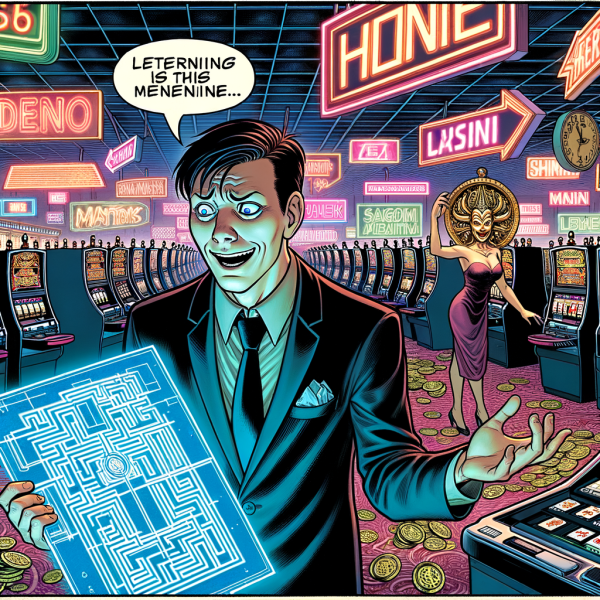The Psychology Behind Casino Floor Designs
Casino floor designs are not merely aesthetic choices; they are meticulously crafted environments that leverage psychological principles to influence player behavior. Designers employ a deep understanding of human psychology, taking advantage of cognitive biases and environmental stimuli to create spaces that encourage prolonged gambling. For instance, the use of labyrinthine layouts can disorient players, making it more difficult for them to navigate their surroundings and prompting them to stay longer than intended.
One of the primary psychological strategies involves creating the illusion of choice. Casinos often place multiple gaming options in close proximity, encouraging players to think they can easily switch games. This illusion can lead to a phenomenon known as the “paradox of choice,” where having too many options results in analysis paralysis. As players become overwhelmed, they may opt to continue playing at their current machine rather than making a decision to leave.
Moreover, the lack of windows and clocks is a deliberate design choice meant to distort players’ sense of time and space. Without these natural markers, individuals can lose track of how long they have been gambling, often leading to extended play sessions. This disorientation is a vital component of the casino’s strategy, ensuring players remain engaged and potentially spend more money.
Lastly, the careful arrangement of high-stakes games near the entrances and low-stakes games deeper within the casino creates a psychological funnel. Newcomers are drawn in by the glitz and glamour of larger payouts, while experienced players are often lured deeper into the casino by the comfort of familiar machines, effectively ensnaring them in the casino’s web.
Creating a Sense of Urgency and Excitement
Casinos capitalize on creating an atmosphere filled with urgency and excitement, essential for maximizing player engagement. Bright lights, pulsating sounds, and dynamic imagery all combine to stimulate the senses and create a high-energy environment. This sensory overload can lead to an adrenaline rush, compelling players to push their limits and continue gambling.
The presence of promotional signs and flashing lights indicating jackpots or ongoing promotions adds to this sense of urgency. Players often feel compelled to act quickly, fearing that a potential opportunity might slip away if they hesitate. These tactics exploit the psychology of FOMO (fear of missing out), driving players to engage in impulsive decision-making.
Additionally, casinos often employ a continual reinforcement loop through the use of rewards. Players may receive complimentary drinks, free spins, or exclusive offers that enhance their experience and encourage repeat visits. This strategy creates a sense of loyalty and urgency, as players feel they must return to the casino to take advantage of these fleeting opportunities.
Furthermore, social dynamics play a crucial role in the excitement of the casino floor. The loud cheers and celebrations from nearby winners create a contagious atmosphere, motivating others to join in and try their luck. This communal excitement can lead to impulsive betting and increased spending as players seek to replicate the joy they witness around them.
How Layouts Manipulate Player Behavior and Choices
The layout of a casino is strategically designed to manipulate player behavior and influence their choices. By placing high-revenue games such as slot machines and table games at key positions, casinos can guide foot traffic where they want it to go. This placement is often accompanied by pathways that lead players deeper into the casino, encouraging exploration and extended play.
Research has shown that the spacing of machines plays a crucial role in player engagement. Closer machine arrangements promote social interaction among players, making them feel more connected and engaged. This social aspect can lead to increased playtime, as individuals are less likely to leave if they are enjoying the company of others or sharing in the excitement.
Moreover, casinos utilize sightlines to manipulate decision-making. By ensuring that popular games are visible from various points within the casino, they create an allure that draws players in. This design not only enhances the visibility of these games but also creates an expectation of potential rewards, further encouraging player participation.
In addition, the strategic placement of amenities, such as bars and restaurants, serves to keep players within the casino for longer periods. The temptation of refreshments and meals provides a convenient distraction, allowing players to take breaks without needing to exit the gambling area. This design fosters extended gaming sessions, increasing overall spending and time spent on the floor.
The Role of Color and Sound in Casino Environments
Color and sound are vital components of casino design, meticulously selected to create an immersive experience that entices players. Bright, bold colors such as red and gold are commonly used due to their associations with excitement, wealth, and luxury. These colors stimulate the senses and evoke strong emotions, drawing players into the gaming experience.
Sound plays an equally important role in the casino environment. The clinking of coins, the ringing of bells, and upbeat music create a soundscape that reinforces the thrill of winning. These auditory cues can trigger dopamine release in the brain, further enhancing the desire to keep playing. In this way, sound functions as both a reward and a motivator.
Furthermore, the use of ambient noise can mask the sounds of loss, making players more willing to continue gambling despite setbacks. By drowning out the negative auditory feedback, casinos create an environment where players are less likely to dwell on their losses and more inclined to chase after wins.
The careful orchestration of color and sound not only enhances the casino’s allure but also serves a tactical purpose in encouraging players to gamble longer. The combination of stimulating visuals and engaging audio creates an enchanting atmosphere that can lead to disorientation and impulsive betting behavior.
The Impact of Disorientation on Gambling Decisions
Disorientation is a key aspect of casino design, strategically employed to enhance gambling decisions that favor the house. As players become lost in the maze-like layout, their ability to make rational choices diminishes. This lack of orientation can lead to impulsive betting, as players are less able to gauge their progress or evaluate their strategies.
Additionally, the absence of clear signage and directions can exacerbate feelings of confusion. Players often find themselves wandering aimlessly, which can lead to frustration. This mental state can further impair decision-making, pushing players to make snap judgments instead of calculated strategies.
Research indicates that disorientation can also lead to an increased likelihood of chasing losses. When players feel lost or overwhelmed, they may be more inclined to risk additional money in an attempt to recover what they have lost, often resulting in even greater losses.
In essence, the design of casino floors creates an environment where disorientation is not just a byproduct but a deliberate strategy. By keeping players off-balance, casinos can manipulate their decisions, leading to extended play and increased profitability.
Strategies for Players to Navigate Casino Spaces Effectively
While casino designs are created to entice and confuse, players can employ strategies to navigate these environments more effectively. First and foremost, setting a strict budget before entering the casino can help maintain control over spending. This financial discipline is essential for preventing impulsive decisions driven by the casino’s design.
Familiarizing oneself with the layout of the casino before diving into games can also be beneficial. Taking a few moments to study maps or ask staff for directions can help players understand where they’re going and what games are available, reducing feelings of disorientation.
Choosing specific games and sticking to them can further enhance strategic decision-making. By limiting options, players can resist the temptation to wander and get distracted by other games, thereby increasing their chances of making informed betting choices.
Lastly, taking regular breaks can help reset a player’s mental state. Stepping away from the gaming floor to enjoy refreshments or simply to gather one’s thoughts can improve clarity and decision-making skills. By implementing these strategies, players can successfully navigate the complex world of casinos without falling prey to their confusing designs.
| Strategy | Description |
|---|---|
| Set a Budget | Determine a spending limit before entering the casino. |
| Familiarize with Layout | Study maps or ask for directions to avoid disorientation. |
| Stick to Specific Games | Limit choices to maintain focus and decision-making clarity. |
| Take Regular Breaks | Step away periodically to refresh and reassess strategies. |
Q&A Section
Q: Why do casinos avoid using windows and clocks?
A: Casinos use this design choice to disorient players and prevent them from tracking the time spent gambling.
Q: How does color affect gambling behavior?
A: Bright colors can stimulate excitement and emotions, encouraging players to engage more with the gaming experience.
Q: What is the paradox of choice in casinos?
A: The paradox of choice refers to the overwhelming feeling players may experience when confronted with too many gaming options, leading to indecision and continued play.
Q: How can players protect themselves from manipulative design?
A: Players can protect themselves by setting budgets, familiarizing themselves with layouts, and taking breaks to maintain clarity in their decision-making.





Wow, who knew casinos were just glorified mazes for our wallets? Next time I go, I’ll bring a map and a compass. Thanks for the enlightening read!